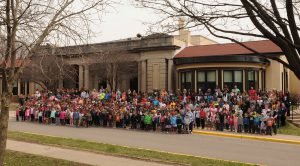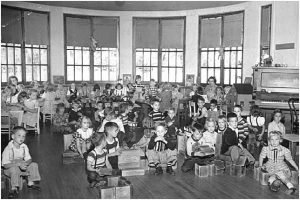By JAN WILLMS
It has been 100 years since Como Park Elementary, 780 W. Wheelock Pkwy., first opened its doors to students. The current school population of 600 students in grades pre-K through 5, is getting ready to celebrate.
 Photo right: A recent Como Elementary school picture. (Photo provided)
Photo right: A recent Como Elementary school picture. (Photo provided)
“We have a big celebration planned for June 2,” said Christine Vang, the school principal. “That is when we also host our annual Como Park Elementary carnival, and we plan to incorporate the 100th anniversary with that event. We have been writing to a lot of constituents in our community and dignitaries from the state, and we hope to have them come and help us celebrate.”
The school is unique in its design and was the first building ascribed to architect Clarence “Cap” Wigington. He was the first African-American municipal architect in the nation. He would go on to design several buildings in St. Paul, including Harriet Island Pavilion (since renamed the Clarence W. Wigington Pavilion), and the Highland Park Water Tower. He also created several of the St. Paul Winter Carnival ice palaces in the late 1930s and 1940s, which showed his more imaginative side.
The original Como Park Elementary had eight classrooms and a kindergarten classroom, according to Vang. “Today we have four sections of all-day kindergarten, and three sections of pre-K,” she said.
 Photo left: A Como Elementary classroom, circa 1951. (Photo provided)
Photo left: A Como Elementary classroom, circa 1951. (Photo provided)
Vang said the original building was expanded in the 1970s, and the newer part housed special education programs. There was Como Elementary Education and Como Elementary Special Education, with services available for children with special needs, autism, or with learning disabilities. Vang said the school has now integrated these programs and is now one Como Park Elementary program. At about the same time as the school had a new addition, a planetarium was built. Como Park Elementary is the only school in the district with a planetarium on site.
Vang said she has done some research on the early days of the school, gathering information from the Minnesota Historical Society and also talking to alumni.
“The initial population of the school was neighborhood children,” Vang said. “Earlier on, many of the students said they would go to school in the morning, then walk home at noon for lunch and return to school for the afternoon. Now, many of the kids come from other neighborhoods and are bused in. We serve breakfast to all the kids, who eat breakfast in their classrooms, as well as the noon lunches.”
Vang said Como Park Elementary is moving into the technology era of teaching and learning. Teachers use a Promethean board to interact with their students, and all students have iPads. There are two computer labs for student use.
“We connect with Como Zoo, and our upper grades are also connected with Big River Journey, which gives them the opportunity to go on trips and learn about the river,” she explained.
Vang said that in preparing for the 100-year celebration, she has found from her research that the concept of Como Park Elementary has not changed that much from its beginning.
“I found pictures of students receiving dental services back in the day,” she noted. “We have a program today that provides dental services, and we also have vision screening for the kids. We offer weekend meals for 45 of our students, and we have a big collection of clothing for families to draw from. That was provided in the early days too. It has been a very community-oriented school from the beginning.”
Vang is also celebrating her 10th anniversary as principal at Como Park. “I am an alumna of St. Paul Public Schools,” she said. “I grew up in St. Paul, starting school here when I was in the third grade. I graduated from Como Senior High, then went to college and got my teaching license. I taught elementary school for seven years in St. Paul and then went to work for the district. I got my administration license, then came back.” Vang said the school is a great building and that the school enjoys a wonderful relationship with the community.
The June 2 celebration (5-7:30pm) will feature many activities, games, and food. Alumni are expected to return, and special hats have been ordered for them to wear.
Wigington, who died in 1967 after a long and successful career in architecture, would be proud of the school he designed that continues to flourish today.
Comments
No comments on this item Please log in to comment by clicking here